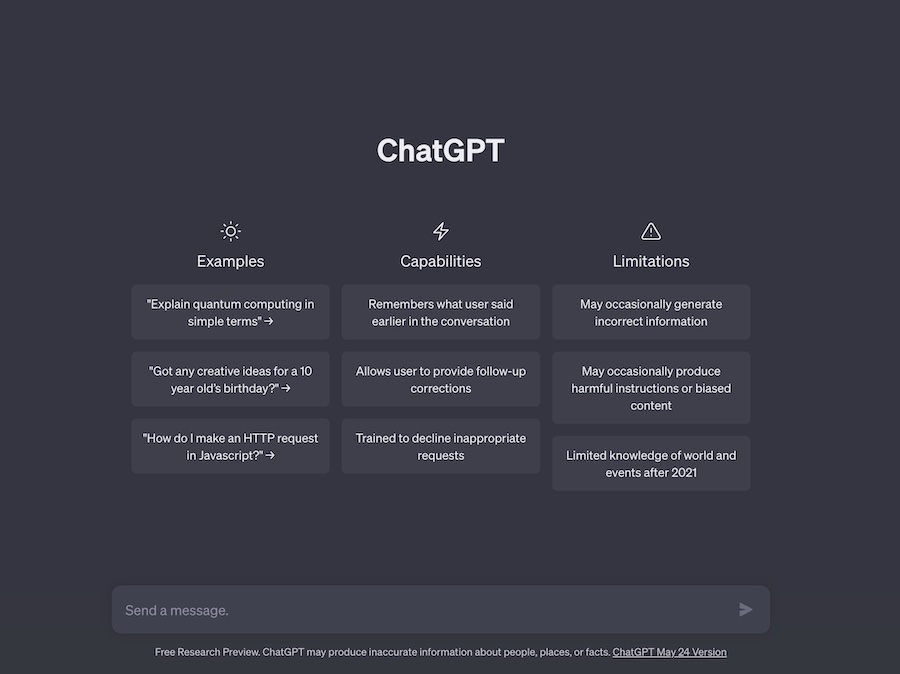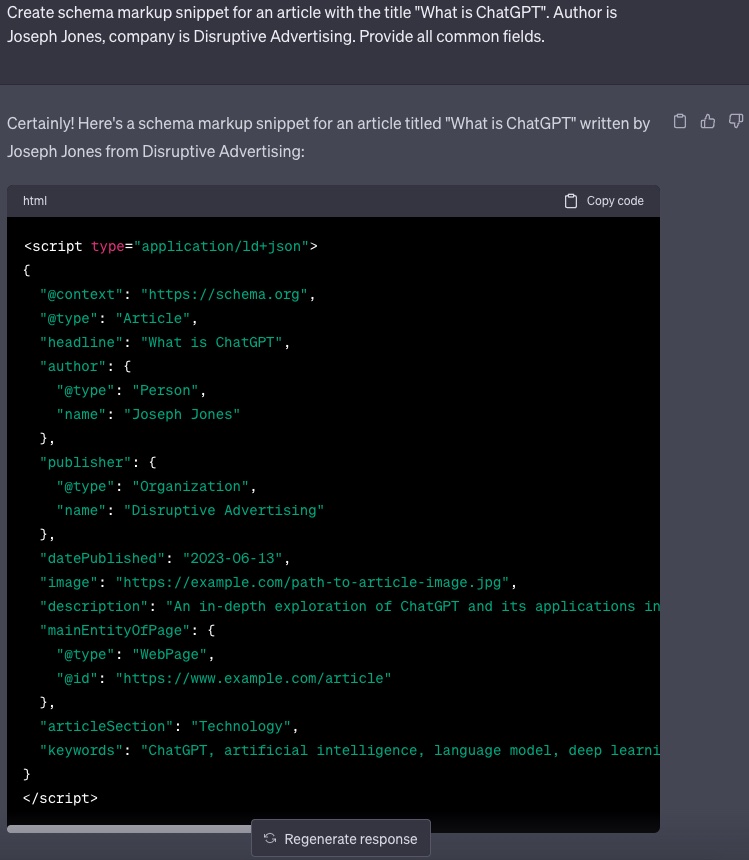What is ChatGPT? You Need to Start Using It
by Joseph Jones • June 13, 2023
Well, we all knew the age of AI would come, but who would have thought it wouldn’t be in the form of Arnold Schwarzenegger as a Terminator from Skynet? (Thank goodness that’s not the case haha).

In the rapidly evolving world of artificial intelligence, ChatGPT stands out as a groundbreaking language model designed to revolutionize human-computer interactions.
Developed by OpenAI, ChatGPT leverages the power of deep learning and natural language processing to provide users with an intuitive and conversational AI experience. It’s actually pretty cool! I’ve been using ChatGPT for a little while now to see how quickly it’s adapted to human language and how to best use it for daily activities. It’s definitely come a long way.
It has its pros and cons, but I’d say there are more pros than cons right now. However, when using ChatGPT, you’ve got to be careful since it’s a highly unregulated platform and the odds of plagiarism arising are extremely high.
There’s even a defamation lawsuit out against OpenAI LLC as of June 5th, 2023. All I can say is: Use ChatGPT as an aid but don’t believe everything you get from it.
I want to lead you into a deep dive of ChatGPT, exploring its features, applications, and its impact on various domains. So, let’s embark on a journey to uncover the wonders of ChatGPT!
I’ll answer some of your burning questions and address some other key points of ChatGPT.
What is ChatGPT?
ChatGPT is an advanced language model that uses deep learning techniques to generate human-like responses in natural language conversations. Built upon the GPT (Generative Pre-trained Transformer) architecture, ChatGPT has been trained on an enormous corpus of text data, allowing it to understand and generate coherent responses to a wide range of prompts and queries.

Take a look at our other article showing you how to use AI for marketing: AI is Disrupting the Market, Are You Using It?
Is ChatGPT safe to use?
OpenAI has made efforts to address concerns related to harmful or biased outputs from ChatGPT. While the system strives to provide accurate and useful information, it may still occasionally produce incorrect or misleading responses (think back to the recent defamation lawsuit).
OpenAI does encourage users to provide feedback to help improve the system and mitigate potential issues. This is done in the form of giving a like or dislike on a response from the system.
Additionally, OpenAI employs a complex content filtering system to prevent the dissemination of inappropriate or harmful content (according to OpenAI).
ChatGPT is technically “safe” to use, but it’s all in how you use it. I’ve been using it for small tasks such as helping me identify target audiences, recreating sentence structures, and even sourcing websites for further market research.
However, other people have used it for writing essays and developing copy to try and blast through their workload (teachers and students have both tried using ChatGPT but it’s also caused issues in the classroom where you could get a failing grade if your work was created by an AI platform – my own sister had this issue where students were falsely accused of using AI to create their reports since it’s become so common to use).
AI is for everyone, but it’s also abused by many.
How does ChatGPT get its information?
ChatGPT acquires its knowledge through pre-training on a vast amount of publicly available text data from the internet. This helps the model develop a broad understanding of language and general knowledge.
However, it is important to note that ChatGPT does not have direct access to real-time information or specific databases. Its responses are based on patterns and information it has learned during training. This AI language model’s knowledge base has a cutoff of September 2021. So if you’re wondering why it’s not giving you up-to-date information, it’s basically 2 years old as of this article’s publication.
How is ChatGPT helping people right now?
ChatGPT has emerged as a powerful tool, transforming various aspects of our daily human lives. Its potential applications are vast and diverse, impacting fields such as customer service, content generation, tutoring, creative writing, and more.
By automating routine tasks and providing quick and (mostly) accurate responses, ChatGPT saves time and improves efficiency, enabling individuals and businesses to focus on more complex and strategic endeavors. Its responses can be super in-depth and extremely valuable or lame and dull. It’s all in how you ask your questions. If you give it enough information, it can create incredible responses.
Applications for ChatGPT
- Customer Support: Companies across industries are leveraging ChatGPT to enhance their customer support services. It can address common queries, guide users through troubleshooting processes, and provide personalized recommendations, ensuring a seamless and interactive support experience. In fact, companies have been using a Beta version of ChatGPT as an actual chatbot on their website to guide users to their answers.
- Content Generation: Content creators and writers can benefit from ChatGPT’s ability to generate coherent text. It can assist in brainstorming ideas, offer writing suggestions, or even help draft initial outlines, speeding up the content creation process while maintaining quality. I don’t recommend using ChatGPT to actually create articles. You don’t know if it’s used the content before for another person’s article. At that point, you’d have plagiarized content.
- Language Learning and Tutoring: ChatGPT can serve as a virtual language tutor, providing learners with interactive conversations, grammar explanations, and vocabulary assistance. This makes language learning more engaging and accessible to a wider audience.
- Personal Assistant: With its conversational abilities, ChatGPT can act as a digital personal assistant. It can help with scheduling appointments, answering questions, providing recommendations, and even engaging in casual conversations, offering a personalized experience tailored to the user’s preferences.
There’s definitely more that ChatGPT can do for users, but it’s all in how you ask. Again, I’ve used it for discovering new audiences for marketing campaigns and even crafting content examples with new tones to better target my messaging to my audience.
Registering for ChatGPT
To access ChatGPT, you can visit the official OpenAI website and create an account. OpenAI offers both free and paid versions of ChatGPT.
Initially, only the paid version was available, but OpenAI has since introduced a freemium model to make it more accessible to users. The free version grants access to a limited set of features, while the paid version, called ChatGPT Plus ($20/mo), offers additional benefits such as faster response times and priority access during peak usage times.
ChatGPT-4 vs. ChatGPT-3
ChatGPT-4 was released on March 12, 2023 and included a paid subscription version to help users get more out of the platform.
Plain and simple, GPT-4 is a more sophisticated version of GPT-3. The responses you get back in GPT-4 are more human-like and it even does a better job of understanding your requests. According to SEJ, GPT-4 is better capable of handling different dialects and cultural variations of a given language.
Along with understanding human requests and using better resources to provide higher-quality answers, GPT-4 is also good at generating code snippets and debugging code problems. GPT-3 had a lot of disconnect in gathering the information users needed to have a clear response for most queries.

Essentially, GPT-4 is a smarter, more powerful, and more human-like version of GPT-3.
Is there a ChatGPT app?
OpenAI did release a mobile app version of ChatGPT that you can download on the Apple Store here. It’s the same as the desktop application of the platform but it also allows you to use voice commands for a hands-free experience that’s more conversational.
However, you can still access ChatGPT through a web browser on your smartphone or tablet. The web-based interface ensures compatibility across multiple platforms and devices, allowing users to engage in conversations with ChatGPT seamlessly.
My ‘final’ thoughts on ChatGPT
ChatGPT has ushered in a new era of conversational AI, enabling users to interact with machines in a more human-like and intuitive manner. Its applications span across multiple domains, offering benefits such as enhanced customer support, content generation, language learning, personal assistance, and market research.
While ChatGPT continues to evolve with each iteration, it is crucial to remain cautious of potential biases or inaccuracies in its responses. As AI technology progresses, ChatGPT represents a significant milestone in bridging the gap between humans and machines, making our interactions with technology more natural and seamless than ever before.





